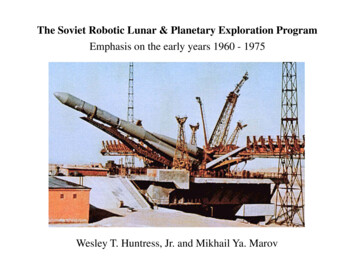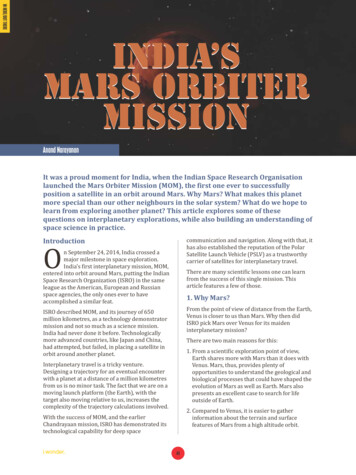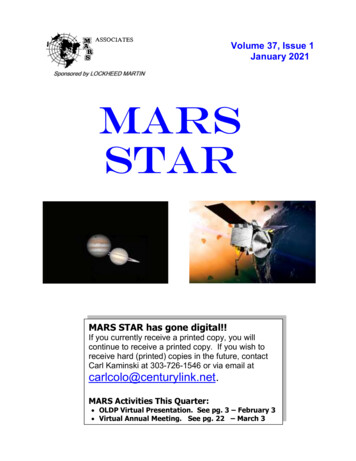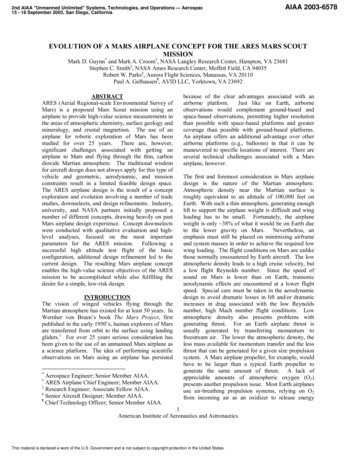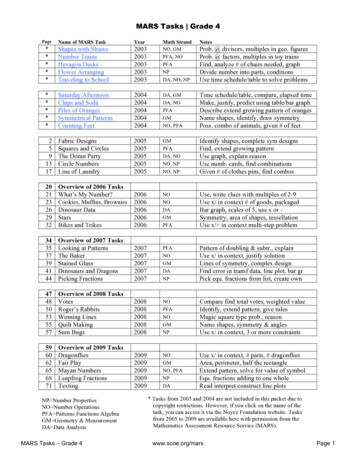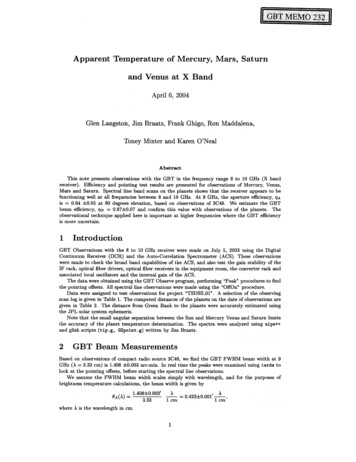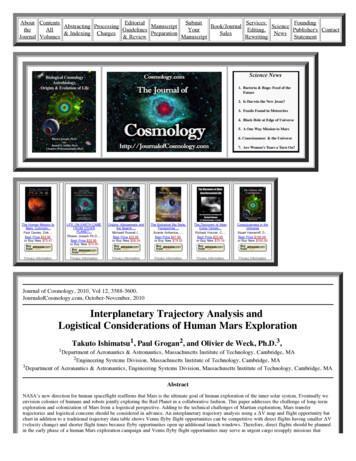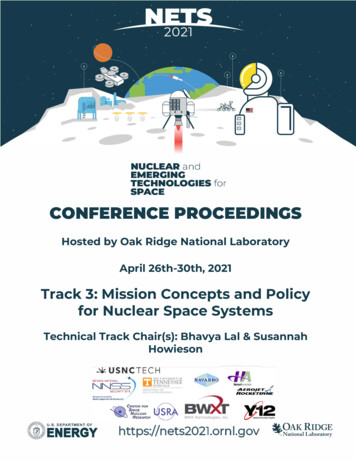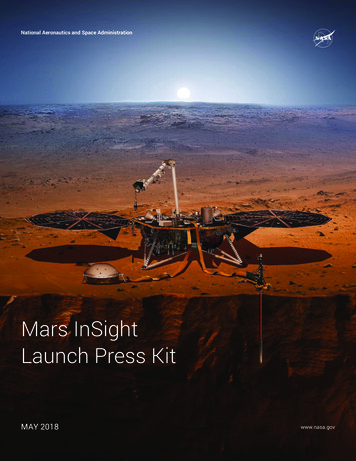
Transcription
IntroductionNational Aeronautics and Space AdministrationMars InSightLaunch Press KitMAY 2018www.nasa.gov1
2
Table of ContentsTable of ContentsIntroduction4Media Services8Quick Facts: Launch Facts12Quick Facts: Mars at a Glance16Mission: Overview18Mission: Spacecraft30Mission: Science40Mission: Landing Site53Program & Project Management55Appendix: Mars Cube One Tech Demo56Appendix: Gallery60Appendix: Science Objectives, Quantified62Appendix: Historical Mars Missions63Appendix: NASA’s Discovery Program653
IntroductionMars InSight Launch Press KitIntroductionNASA’s next mission to Mars -- InSight -- will launch fromVandenberg Air Force Base in California as early as May 5,2018. It is expected to land on the Red Planet on Nov. 26,2018. InSight is a mission to Mars, but it is more than a Marsmission. It will help scientists understand the formation andearly evolution of all rocky planets, including Earth.A technology demonstration called Mars Cube One (MarCO)will share the launch with InSight and fly separately to Mars.Six Ways InSight Is DifferentNASA has a long and successful track record at Mars. Since 1965, it has flownby, orbited, landed and roved across the surface of the Red Planet.None of that has been easy. Only about 40 percent of the missions ever sent toMars by any space agency have been successful. The planet’s thin atmospheremakes landing a challenge; its extreme temperature swings make it difficult tooperate on the surface.But if a spacecraft survives the trip, there’s a bounty of science to be collected.What can InSight do that hasn’t been done before?4
Introduction1. InSight is the first mission to study the deep interior of MarsA dictionary definition of “insight” is to see the inner nature of something. InSight (InteriorExploration using Seismic Investigations, Geodesy and Heat Transport) will do just that.InSight will take the “vital signs” of Mars: its pulse (seismology), its temperature (heat flow),and its reflexes (radio science). It will be the first thorough check-up since the planet formed4.5 billion years ago.The mission is led by NASA’s Jet Propulsion Laboratory in Pasadena, Calif.2. InSight will teach us about theinterior of planets like our ownInSight’s team hopes that by studying the deep interior of Mars, we can learn how other rockyworlds, including Earth and the Moon, formed. Our home planet and Mars were molded fromthe same primordial stuff more than 4.5 billion years ago, but then became quite different.Why didn’t they share the same fate?When it comes to rocky planets, we’ve only studied one in detail: Earth. By comparing Earth’sinterior to that of Mars, InSight’s team members hope to better understand our solar system.What they learn might even aid the search for Earth-like exoplanets, narrowing down whichones might be able to support life. So while InSight is a Mars mission, it’s also much morethan a Mars mission.3. InSight will try to detect marsquakes for the first timeOne key way InSight will peer into the Martian interior is by studying motion underground-- what we know as marsquakes. NASA hasn’t attempted to do this kind of science sincethe Viking mission. Both Viking landers had their seismometers on top of the spacecraft,where they produced noisy data. InSight’s seismometer will be placed directly on the Martiansurface, which will provide much cleaner data.Scientists have seen a lot of evidence suggesting Mars has quakes. But unlike quakes onEarth, which are mostly caused by tectonic plates moving around, marsquakes would becaused by other types of tectonic activity, such as volcanism and cracks forming in theplanet’s crust. In addition, meteor impacts can create seismic waves, which InSightwill try to detect.Each marsquake wll be like a flashbulb that illuminates the structure of the planet’s interior.By studying how seismic waves pass through the different layers of the planet (the crust,mantle and core), scientists can deduce the depths of these layers and what they’re made of.In this way, seismology is like taking an X-ray of the interior of Mars.Scientists think it’s likely they’ll see between a dozen and a hundred marsquakes over thecourse of two Earth years. The quakes are likely to be no bigger than a 6.0 on the Richterscale, which would be plenty of energy for revealing secrets about the planet’s interior.5
Introduction4. First interplanetary launch from the West CoastAll of NASA’s interplanetary launches to date have been from Kennedy Space Center in CapeCanaveral, Florida, in part because the physics of launching off the East Coast are better forjourneys to other planets. But InSight will break the mold by launching from Vandenberg AirForce Base in Central California. It will be the first launch to another planet from the West Coast.InSight will ride on top of a powerful Atlas V 401 rocket, which allows for a planetary trajectoryto Mars from either coast. Vandenberg was ultimately chosen because it had more availabilityduring InSight’s launch period.A whole new region will get to see an interplanetary launch when InSight rockets intothe sky. In a clear, pre-dawn sky, the launch may be visible in California fromSanta Maria to San Diego.5. InSight could teach us howMartian volcanoes were formedMars is home to some impressive volcanic features. That includes Tharsis -- a plateauwith some of the biggest volcanoes in the solar system. Heat escaping from deep withinthe planet drives the formation of these types of features, as well as many others on rockyplanets. InSight includes a self-hammering heat probe that will burrow up to 16 feet (5meters) into the Martian soil to measure the heat flow from the planet’s interior for the firsttime. Combining the rate of heat flow with other InSight data will reveal how energy withinthe planet drives changes on the surface.6. Mars is a time machineStudying Mars lets us travel to the ancient past. While Earth and Venus have tectonicsystems that have destroyed most of the evidence of their early history, much of the RedPlanet has remained static for more than 3 billion years. Because Mars is just one-thirdthe size of Earth and Venus, it contains less energy to power the processes that change aplanet’s structure. That makes it a fossil planet in many ways, with the secrets of our solarsystem’s early history locked deep inside.6
IntroductionWhat Makes MarsCube One DifferentMarCO is the first CubeSat mission to deep spaceThe rocket that will loft InSight beyond Earth will also launch a separate NASA technologyexperiment: two mini-spacecraft called Mars Cube One, or MarCO. These briefcase-sizedCubeSats will fly on their own path to Mars behind InSight.Their goal is to test new miniaturized deep space communication equipment and, if theMarCOs make it to Mars, may relay back InSight data as it enters the Martian atmosphereand lands. This will be a first test of miniaturized CubeSat technology at another planet,which researchers hope can offer new capabilities to future missions.If successful, the MarCOs could represent a new kind of communication capability to Earth.InSight’s success is independent of its CubeSat tag-alongs.7
Media ServicesMedia ServicesMedia ContactsPolicy/Program ManagementInSight MissionHeadquarters, WashingtonNASA Jet Propulsion Laboratory Pasadena, CaliforniaDwayne BrownJoAnna WendelD.C. AgleAndrew 18-653-6297 (cell)626-840-4291 ia-Rui CookLaunchKennedy Space Center, Florida818-354-0724626-524-6483 (cell)jccook@jpl.nasa.govTori raftLockheed Martin Space Denver, ColoradoLaunch Vehicle and OperationsUnited Launch Alliance Cape Canaveral, FloridaDani Hauf303-932-4360danielle.m.hauf@lmco.comHeather ch SiteVandenberg Air Force Base Central, CaliforniaNASA Discovery ProgramMarshall Space Flight Center Huntsville, AlabamaMolly Porter256-544-0034molly.a.porter@nasa.gov8Lt. Amy Rasmussen805-606-3595amy.rasmussen@us.af.mil
Media ServicesScience Payload InstrumentsTechnology DemonstrationSeismic Experiment for Interior StructureMars Cube OneCentre National d’Études Spatiales (CNES)Paris, FranceNASA Jet Propulsion Laboratory Pasadena, CaliforniaClaire DramasNathalie 27-39-11626-840-4291 andrew.c.good@jpl.nasa.govAndrew GoodHeat Flow and Physical Properties PackageDeutsches Zentrum für Luft- und Raumfahrt (DLR)Berlin, GermanyManuela cts and EventsNews Releases, Features andStatus ReportsVideo and ImagesMission news, updates and feature stories about InSightvimeo.com/261856765An InSight media reel is available at:will be available at:nasa.gov/insight, andA Mars Cube One media reel is available at:mars.nasa.gov/insight.vimeo.com/265040492Video and images related to the InSight mission areavailable at:vimeo.com/jplraw,go.usa.gov/xnUXj andgo.nasa.gov/2mp2KsJThe NASA image use policy is available at:nasa.gov/multimedia/guidelines/index.htmlThe JPL image use policy is available at:jpl.nasa.gov/imagepolicy9
Media ServicesMedia EventsThe most up-to-date information about upcoming InSight media events and where they may be viewed can be found on theInSight Launch Page at: mars.nasa.gov/insight/mission/timeline/launch/ More information on NASA TV and streamingchannels can be found below in the press kit’s “how to watch” section.BriefingsMedia OpportunityA news conference presenting an overview of the missionU.S. media are invited to view the InSight lander Friday,will take place at NASA’s Jet Propulsion Laboratory inApril 6, at Vandenberg Air Force Base in California, where itPasadena, Calif., on March 29, 2018, at 5 p.m.undergoes final tests for its May launch. Media planning toEDT (2 p.m. PDT).attend this event must send their driver’s license numberand state of issue, date of birth, and name of their mediaIf a May 5 launch attempt is still planned, a pre-launchoutlet and editor’s contact information, to 2nd Lt. Amybriefing open to accredited news media and NASA SocialRasmussen at amy.rasmussen@us.af.mil no later thanparticipants is scheduled on May 3, 2018, at 1 p.m. PDT (4noon PDT (3 p.m. EDT), Friday, March 30. Due to spacep.m. EDT) at Vandenberg Air Force Base. This program willrestrictions, only two representatives from each mediabe broadcast and streamed. A post-launch news conferenceoutlet will be allowed to participate. More information willat Vandenberg Air Force Base may begin approximately twobe provided to registered media regarding access, arrivalto three hours after launch.and event times as details are finalized.Live Launch FeedOn-Site Media LogisticsA live video feed of key launch activities and commentaryNews media representatives who would like to cover thefrom the mission control room at Vandenberg Air ForceInSight launch and pre-launch media briefings in personBase will be broadcast. If a May 5 launch attempt is stillat Vandenberg Air Force Base must be accredited throughplanned, it is expected to be broadcast starting at 3:30 a.m.Vandenberg. Journalists may contact Lt. Amy RasmussenPDT (6:30 a.m. EDT). The first launch opportunity begins atat 805-606-3595 or amy.rasmussen@us.af.mil for more4:05 a.m. PDT (7:05 a.m. EDT) on May 5 and lasts for twoinformation.hours.Non-U.S. journalists must apply for credentials by Monday,The first launch opportunity begins at 4:05 a.m. PDT (7:05April 2, 12:00 p.m. PDT (3:00 p.m. EDT);a.m. EDT) on May 5 and lasts for two hours.U.S. journalists by Wednesday, April 18, 12:00 p.m. PDT(3:00 p.m. EDT).Interviews in the Vandenberg area may be arranged bycalling a JPL media representative at 626-864-0552 or626-773-0370.Public Viewing LocationsOn May 5, there will be two official public viewing sites in Lompoc (one at the Lompoc Airport and the other at St. Mary’sEpiscopal Church) that are open to all. More information on these sites is available atch-in-person.10
Media ServicesHow to Watch (Live and On Demand)News briefings and launch commentary will be streamed on NASA TV, NASA.gov/live, YouTube.com/NASAJPL/live and Ustream.tv/NASAJPL. (On-demand recordings will also be available after the live events have finished onthe YouTube and Ustream pages.) Any additional feeds or streams will be listed in the “Watch Online” section ofmars.nasa.gov.NASA TV channels are digital C-band signals carried by QPSK/DVB-S modulation on satellite Galaxy-13,transponder 11, at 127 degrees west longitude, with a downlink frequency of 3920 MHz, vertical polarization, datarate of 38.80 MHz, symbol rate of 28.0681 Mbps and 3/4 FEC. A Digital Video Broadcast-compliant IntegratedReceiver Decoder is needed for reception.Audio OnlyAudio only of launch coverage will be carried on the NASA “V” circuits, which may be accessed by dialing321-867-1220, -1240, -1260 or 7135. On launch day, “mission audio,” the launch conductor’s countdown activitieswithout NASA TV launch commentary, will be carried on 321-867-7135.Eyes on the Solar SystemAs soon as the InSight spacecraft separates from the second stage of itsrocket and begins flying on its own, the public can begin following InSight’spath to Mars in real-time through NASA’s Eyes on the Solar System.Eyes is available on the Web at eyes.nasa.gov/.Additional Resources on the WebSocial MediaOnline and PDF versions of this press kit are available at:Join the conversation and get mission updates fromjpl.nasa.gov/news/press kits/insight/launch/InSight, JPL and NASA via these accounts:Additional detailed information about InSight is available at:Twitter: @NASAInSight, @NASAJPL, @NASAmars.jpl.nasa.gov/insightFacebook: @NASAInSight, @NASAJPL, @NASAInstagram @NASAJPL, @NASA11
Quick Facts: Launch FactsQuick Facts: Launch FactsMission FirstsInSight is the first Mars mission dedicated to studying the planet’s deep interior.InSight is the first mission to place a seismometer directly on the Martian surface.InSight will try to detect quakes for the first time on another planet.InSight is the first to use a self-hammering mole to burrow deep into the crust of Mars, going15 times deeper than any previous Mars mission, to a depth of 10 to 16 feet (3 to 5 meters).InSight is the first interplanetary launch from the West Coast.InSight is the first spacecraft to use a robotic arm to grasp instruments on another planet.InSight’s magnetometer is the first ever used on the surface of Mars.MarCO is the first mission to test CubeSats in deep space.Mission NameThe long form of the mission’s name is Interior Explorationusing Seismic Investigations, Geodesy and Heat Transport,which includes the three main research techniques to beused by the InSight stationary lander. A dictionary definitionof “insight” is to see the inner nature of something.12
Quick Facts: Launch FactsSpacecraftInSight cruise vehicle dimensions (cruise stage and aeroshell with lander inside): Height: 5 feet, 9 inches (1.76 meters);aeroshell diameter: 8 feet, 8 inches (2.64 meters); wingspan of cruise solar arrays: 11 feet, 2 inches (3.40 meters)InSight Lander DimensionsMars Cube One (MarCO) DimensionsHeight range (after its legs compress a still-to-be-Twin spacecraft, each 14.4 inches (36.6 centimeters) by 9.5determined amount during impact): between 33 to 43 inchesinches (24.3 centimeters) by 4.6 inches (11.8 centimeters)(83 to 108 centimeters) from the bottom of the legs to thetop of the deck; Span with solar arrays deployed: 19 feet,8 inches (6.00 meters); width of deck: 5 feet, 1 inch (1.56meters); length of robotic arm: 5 feet, 11 inches (1.8 meters)MassPowerAbout 1,530 pounds (694 kilograms) total of InSightSolar panels and lithium-ion batteries on both InSight andspacecraft at launch. The spacecraft includes the lander,MarCO. On InSight, the two solar array panels togetherwhich is about 790 pounds (358-kilograms), the 418-poundprovide about 1,800 watts on Earth on a clear day. On Mars,(189-kilogram) aeroshell, 174-pound (79-kilogram) cruisethey provide 600-700 watts on a clear day, or just enough tostage and 148 pounds (67 kilograms) of loaded propellantpower a household blender. They’re estimated to provide 200-and pressurant. Mass of each MarCO spacecraft:300 watts on a dusty day, even with dust covering the panels.30 pounds (13.5 kilograms). Total payload mass on therocket: 1,590 pounds (721 kilograms)InSight Science PayloadCamerasAbout 110 pounds (50 kilograms), including SeismicOne camera on InSight’s robotic arm and one camera on theExperiment for Interior Structure, Heat Flow and Physicalspacecraft’s lander deck, both capable of producing colorProperties Package, Auxiliary Payload Sensor Suite,images of 1,024 pixels by 1,024 pixels. On each MarCO: aInstrument Deployment System and Laser Retroreflector.wide-field camera (primarily to confirm high-gain antenna(The Rotation and Interior Structure Experiment uses thedeployment). On MarCO-B: a narrow-field camera. Each kindlander’s telecommunications system.)of camera on MarCO is capable of color images 752 x 480pixels in resolution.13
Quick Facts: Launch FactsLaunch VehicleType: Atlas V 401Height with payload: 188 feet (57.3 meters)MissionLaunch period: May 5 through June 8, 2018Launch windows: May 5 window opens at 4:05 a.m. PDT (7:05 a.m. EDT; 11:05 UTC) and lasts fortwo hours. On subsequent dates, the window opens a few minutes earlier each day, to 1:30 a.m.PDT (4:30 a.m. EDT) by June 8, and remains open for up to two hoursLaunch site: Space Launch Complex 3, Vandenberg Air Force Base, CaliforniaEarth-Mars distance on May 5, 2018: 75 million miles (121 million kilometers)Travel distance, Earth to Mars (May 5 launch): About 301 million miles (485 million kilometers)Mars landing: Nov. 26, 2018, about noon PST (3 p.m. EST; 20:00 UTC). At the Mars landing site,this will be mid-afternoon on a winter dayLanding site: About 4.5 degrees north latitude, 135.9 degrees east longitude, in Elysium PlanitiaEarth-Mars distance on Nov. 26, 2018: 91 million miles (146 million kilometers)One way radio transit time, Mars to Earth, on Nov. 26, 2018: 8.1 minutesMission: One Martian year plus 40 Martian days (nearly 2 Earth years), until Nov. 24, 2020Expected near-surface atmospheric temperature range at landing site during primary mission:minus 148 F to minus 4 Fahrenheit (minus 100 Celsius to minus 20 Celsius)14
Quick Facts: Launch FactsProgramU.S. investment in InSight mission is 813.8 million,including about 163.4 million for launch vehicle andlaunch services, and the rest for the spacecraft andoperations through the end of the prime mission. Inaddition, France and Germany, the major Europeanparticipants, have invested about 180 million inInSight’s investigations, primarily the seismometerinvestigation (SEIS) and heat flow investigation (HP3).JPL and NASA are investing about 18.5 million for theMars Cube One technology.15
Quick Facts: Mars at a GlanceQuick Facts: Mars at a GlanceGeneral One of five planets known to ancients; Mars was the Romangod of war, agriculture and the state Yellowish brown to reddish color; occasionally the thirdbrightest object in the night sky after the Moon and VenusPhysical Characteristics Average diameter 4,212 miles (6,780 kilometers);about half the size of Earth, but twice the size of Earth’s Moon Same land area as Earth, reminiscent of a cold, rocky desert Mass 1/10th of Earth’s; gravity only 38 percent asstrong as Earth’s Density 3.9 times greater than water (Earth’s density is 5.5times greater than water) No planet-wide magnetic field detected; only localizedancient remnant fields in various regionsOrbit Fourth planet from the Sun, the next beyond Earth About 1.5 times farther from the Sun than Earth Orbit elliptical; distance from the Sun varies from a minimumof 128.4 million miles (206.7 million kilometers) to a maximumof 154.8 million miles (249.2 million kilometers); average is141.5 million miles (227.7 million kilometers) Revolves around the Sun once every 687 Earth days Rotation period (length of day) is 24 hours, 39 minutes, 35seconds (1.027 Earth days) Pole is tilted 25 degrees, creating seasons similarto those on Earth16
Quick Facts: Mars at a GlanceEnvironment Atmosphere composed chiefly of carbon dioxide (95.3%),nitrogen (2.7%) and argon (1.6%) Surface atmospheric pressure less than 1/100th that ofEarth’s average Surface winds of 0 to about 20 mph (0 to about 10 metersper second), with gusts to about 90 mph (more than 140kilometers per hour) Local, regional and global dust storms; also whirlwindscalled dust devils Surface temperature averages minus 64 Fahrenheit (minus53 Celsius); varies from minus 199 Fahrenheit (minus 128Celsius) during polar night to 80 Fahrenheit (27 Celsius) at theequator during midday, at its closest point in orbit to the SunFeatures Highest point is Olympus Mons, a huge shield volcano about16 miles (26 kilometers) high and 370 miles (600 kilometers)across; has about the same area as Arizona Canyon system of Valles Marineris is largest and deepestknown in solar system; extends more than 2,500 miles (4,000kilometers) and has 3 to 6 miles (5 to 10 kilometers) of relieffrom floors to tops of surrounding plateausMoons Two irregularly shaped moons, each only a few miles(kilometers) wide Larger moon named Phobos (“fear”); smaller is Deimos(“terror”), named for attributes personified in Greek mythologyas sons of the god of war17
Mission: OverviewMission: OverviewInSight will launch in May or June 2018 from CentralThe Mars Cube One (MarCO) technology demonstration willCalifornia. If skies are clear, the pre-dawn launch will likely beshare InSight’s launch and fly separately to Mars.visible from much of coastal Southern California, includingthe Los Angeles and San Diego metropolitan areas.Key activities of the InSight mission are launch, cruise,arrival (also known as entry, descent and landing) and MarsThe InSight spacecraft will fly for about six months to hit asurface operations.target point at the top of the Martian atmosphere at aboutsix times the speed of a high-velocity bullet; decelerateenough in seven minutes for a safe touchdown on Mars bya three-legged lander; use a robotic arm for the first time tograsp science instruments and then place them directly ontothe surface of Mars over the course of a few weeks; pound aIllustration ofInSight at launchprobe deeper into the Martian ground than ever before; thencollect clues about the planet’s interior until November 2020.Launch VehicleA two-stage Atlas V 401 launchvehicle will lift the InSight spacecraftfrom Space Launch Complex 3 ofVandenberg Air Force Base, onCentral California’s Pacific coast.The vehicle and launch services areprovided by United Launch Alliance,Centennial, Colorado, a joint ventureof Boeing Co. and Lockheed MartinCorp. The three numbers in the 401designation signify a payload fairing-- or nose cone -- that is about 13 feet(4 meters) in diameter; zero solid-rocket boosters supplementing theAtlas V 401 launch vehicle, expanded viewmain booster, and one engine on theupper stage. NASA selected an AtlasV 401 as InSight’s launch vehicle inDecember 2013.18
Mission: OverviewThis launch vehicle’s first stage is the common core boosterengine, when the vehicle has climbed high enough to havewith its fuel and liquid-oxygen tanks. This main booster isescaped most of Earth’s atmosphere.107 feet (32.5 meters) long, with a diameter of 12.5 feet(3.8 meters). It has a throttleable RD-180 engine from aWith the payload fairing on top, the Atlas V 401 ready forjoint venture of United Technologies Corporation’s Prattlaunch will stand approximately 188 feet (57.3 meters) tall.& Whitney Division, East Hartford, Connecticut, and NPOEnergomash, Moscow. Thermally stable kerosene fuel (typeRP-1) and liquid oxygen will be loaded shortly before launchinto cylindrical fuel tanks that make up about half of the totalPrevious Atlas Launchesheight of the vehicle. The common core booster can provideThe first Atlas V was launched in August 2002. In-thrust of up to about 850,000 pounds (3.8 million newtons)Sight’s launch is scheduled to be the 62nd Atlas Vat full throttle, controlled by an avionics system that provideslaunch. An Atlas V 401 sent NASA’s Mars Reconnais-guidance and sequencing functions.sance Orbiter on its way to Mars on Aug. 12, 2005; anAtlas V 541 launched NASA’s Mars Science LaboratoryTwo interstage adapters connect the first stage of thespacecraft, including the Curiosity rover, on Nov. 26,Atlas with its Centaur upper stage. The Centaur is 41.7 feet2011; and an Atlas V 401 launched NASA’s Mars Atmo-(12.7 meters) long and 10.2 feet (3.1 meters) in diameter,sphere and Volatile Evolution (MAVEN) orbiter on Nov.with a restartable RL-10C engine from Aerojet Rocketdyne,18, 2013. Other NASA deep space missions with AtlasSacramento, California. This engine uses liquid hydrogen andV launches have included New Horizons (to Pluto)liquid oxygen and can provide up to about 22,890 poundsin 2006, Juno (to Jupiter) in 2011, and Origins, Spec-(101,820 newtons) of thrust. The Centaur can control itstral Interpretation, Resource Identification, Security,orientation precisely, which is important for managing theRegolith Explorer (OSIRIS-REx asteroid sample-returndirection of thrust while its engine is firing. It carries its ownmission) in 2016.flight control computer and can release its payload with thedesired attitude and spin rate.The Centaur’s aft bulkhead carrier holds the CubeSatdeployment system that will contain the MarCO-A andMarCO-B CubeSats during the launch and release them afterleaving Earth orbit. The interstage adapter attached to theCentaur encloses the aft bulkhead carrier while the stagesare linked. At the other end of the upper stage, the Centaur’sforward adapter provides structural and electronic interfaceswith the InSight spacecraft.The InSight spacecraft will ride into the pre-dawn sky inside aprotective payload fairing atop the Centaur stage. The fairingis 40 feet (12.2 meters) long, with a diameter of 13.8 feet (4.2meters) at the widest part, tapering to the top of the cone.It will be jettisoned shortly after ignition of the Centaur’sLaunch Schedulingand LocationAs Earth and Mars race around the Sun, with Earth on theinside track, Earth laps Mars about once every 26 months.Launch opportunities to Mars occur at the same frequency,when the planets are positioned so that a spacecraftlaunched from Earth will move outward and intersect Mars inits orbit several months later. This planetary clockwork, plusthe launch vehicle’s power, the spacecraft’s mass, and thedesired geometry and timing for the landing on Mars are allfactors in determining the range of possible launch dates.InSight’s launch period is May 5 through June 8, 2018, withmultiple launch opportunities over windows of approximately19
Mission: Overviewtwo hours each date. Launch opportunities are set fiveThe most recent Atlas V liftoff from Vandenberg was theminutes apart during each date’s window. The first launchSept. 24, 2017, launch of a National Reconnaissance Officeopportunity will begin at 4:05 a.m. PDT (7:05 a.m. EDT /spacecraft. For safety, launches are directed seaward.11:05 UTC) on May 5.All previous NASA interplanetary missions have launchedWhichever date the launch occurs, InSight’s landing onfrom Florida’s Atlantic coast, at either Cape Canaveral AirMars is planned for Nov. 26, 2018, around noon PST (3 p.m.Force Station or the adjacent NASA Kennedy Space Center.EST / 20:00 UTC).Launching toward the east adds the momentum of Earth’seastward rotation to the launch vehicle’s own thrust. ForVandenberg Air Force Base is near Lompoc, California,InSight, the Atlas V 401 offers enough performance to enableabout one-third of the way from Los Angeles to Sanlaunching a Mars mission southward from Vandenberg,Francisco on the Pacific Coast. The base is headquarters ofmitigating a more-crowded launch schedule in Florida.the 30th Space Wing, U.S. Air Force Space Command.InSight is the first interplanetary launch from the WestCoast. Most launches from Vandenberg put Earth satellitesinto near-polar orbits. Examples include NASA Earthscience missions Soil Moisture Active Passive, launched in2015, and Orbiting Carbon Observatory 2, launched in 2014.VisibilityIf the weather is clear, the InSight launchcould be visible from as far north asBakersfield, California, to perhaps as farsouth as Rosarito, Mexico.Launch SequencesThe launch time, called “T Zero,” is when the engine is ready and 1.1 seconds before liftoff. Ignition of the Atlas V-401first-stage common core booster is at 2.7 seconds before T Zero, or 3.8 seconds before liftoff.After a short vertical rise away from the pad, the launch vehicle will begin a maneuver to travel in its prescribeddirection (southward). The common core booster engine of the first stage will continue to burn until about 244 secondsafter T Zero, ending with “booster engine cutoff,” or BECO.About six seconds after booster engine cutoff, the first stage will be jettisoned from the Centaur upper stage. It willfall into the Pacific Ocean. At the separation of the two stages, the interstage adapters will also fall away, exposing theCentaur’s aft bulkhead carrier where the twin MarCO spacecraft ride inside their CubeSat dispensers. Approximately 10seconds after separation of the two stages, the Centaur engine will begin the first of its two burns. The launch vehiclewill jettison the payload fairing eight seconds later, uncovering InSight. The first burn of the Centaur’s engine, lastingabout nine minutes, will insert the combined upper stage and spacecraft into a parking orbit. The end of this burn iscalled “main engine cutoff one,” or MECO
NASA’s next mission to Mars -- InSight -- will launch from Vandenberg Air Force Base in California as early as May 5, 2018. It is expected to land on the Red Planet on Nov. 26, 2018. InSight is a mission to Mars, but it is more than a Mars miss
